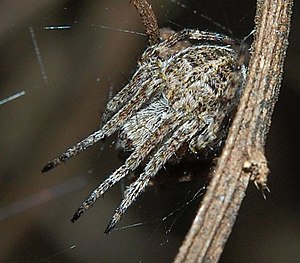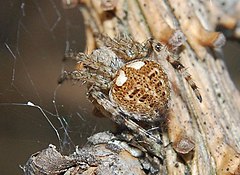Cup spider
| Cup spider | ||||||||||||
|---|---|---|---|---|---|---|---|---|---|---|---|---|

Cup spider ( Agalenatea redii ), female |
||||||||||||
| Systematics | ||||||||||||
|
||||||||||||
| Scientific name | ||||||||||||
| Agalenatea redii | ||||||||||||
| ( Scopoli , 1763) |
The basket spider ( Agalenatea redii ) is a species of the genus Agalenatea within the family of the real orb web spiders (Araneidae). This relatively small orb web spider is common in Central Europe, but not very common.
features
The species is significantly smaller than the well-known garden spider . Males are 3.5 to 5.5 mm long, females 7 to 8 mm long. The very hairy front body ( prosoma ) is light beige-brown in color.
The back of the body ( opisthosoma ), which is also densely hairy, is somewhat wider than it is long. The basic color is quite uniformly yellowish brown, but the pattern is variable. Usually there is a multiple interrupted, dark central band to which several pairs of straight, parallel, dark and mostly light-edged transverse bands border on the sides. Occasionally two large, roughly rectangular white spots are formed in the front part of the back of the body, or the median stripe is completely absent and the opisthosoma instead shows a large, dark, light-edged spot on the back part. The legs are not very contrasting light dark ringed.
distribution and habitat
The basket spider inhabits large parts of the Palearctic from Ireland and the Canary Islands to the Pacific, as well as Africa north and south of the Sahara. The distribution area here includes large parts of the temperate to tropical zones. It occurs all over Europe.
The species loves warmth and is bound to forest-free, open biotopes. It settles mainly on dry and semi-arid grasslands ; in eastern Germany it is known as a pointer species for dwarf shrub heaths .
Way of life
The net is laid low, mostly between dried shrubs and grasses from the previous year. Next to the web, the spider creates a seating area that is often not very obvious and is open at the top, where it almost always stays. It sits there very exposed, but is very well camouflaged due to its drawing on the top and is not very conspicuous. The species is often active very early in the year, sexually mature animals can then be observed as early as April.
Danger
In Germany, the population of the species is declining, at least regionally, due to the close connection to extensively used open land habitats. It is listed as "endangered" (Category 3) in the Red Lists of Schleswig-Holstein, Mecklenburg-Western Pomerania and Berlin, and it is on the warning list in Baden-Württemberg. Nationwide, however, it is still considered safe.
Web links
Agalenatea rediiin the World Spider Catalog
literature
- Heiko Bellmann: Cosmos Atlas Arachnids of Europe . 3rd edition, 2006. Kosmos, Stuttgart, ISBN 978-3-440-10746-1 .
- Ralph Platen, Bodo von Broen, Andreas Herrmann, Ulrich M. Ratschker & Peter Sacher: Total species list and red list of spiders, harvestmen and pseudoscorpions of the state of Brandenburg (Arachnida: Araneae, Opiliones, Pseudoscorpiones) with information on frequency and ecology. Nature conservation and landscape management in Brandenburg 8, booklet 2 (supplement); 1999.
Individual evidence
- ↑ Natural History Museum of the Burgergemeinde Bern: World Spider Catalog Version 17.5 - Agalenatea redii . Retrieved August 2, 2016.
- ↑ http://www.britishspiders.org.uk/html/bas.php?page=world&taxon_key=nbnsys0100001382 Map of the worldwide distribution of the basket spider from the British Arachnological Society
